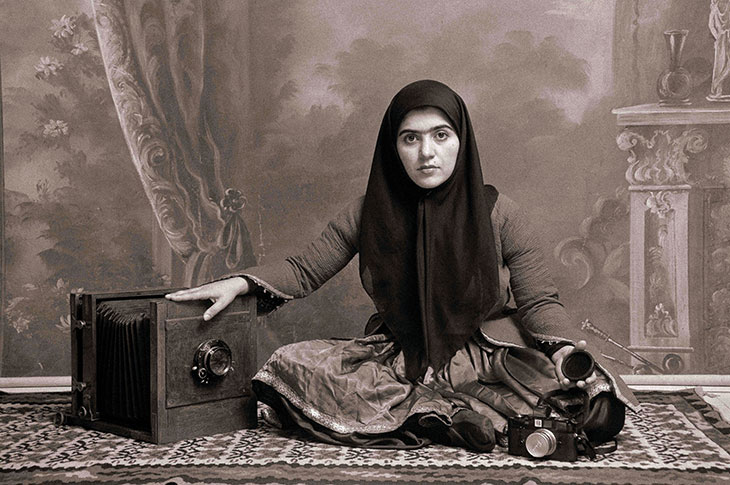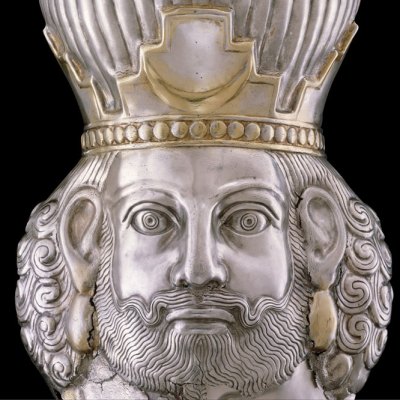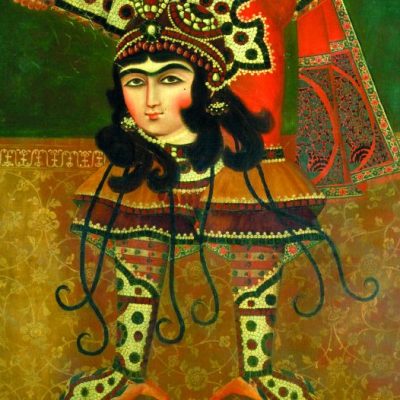In Britain, at least, Iranian culture is always being discovered. William Morris and Edward Burne-Jones led the way with their loans to the ‘Persian and Arab Art’ exhibition at the Burlington Fine Arts Club in 1885. In 1931, more than 2,000 objects were displayed at the ‘International Exhibition of Persian Art’ at the Royal Academy, facilitated by Iran’s monarch Reza Shah Pahlavi. Though the RA show prompted public and scholarly interest, Iran’s Islamic revolution of 1979 has blinded the West to the country’s rich history. The British Museum called its 2005 blockbuster on ancient Persia, ‘Forgotten Empire’.
Now we have the V&A’s pointedly titled ‘Epic Iran’. The term ‘Persia’, bestowed by the Greeks, has murky colonial connotations, and Pars (or Fars) is the name of a specific area in south-western Iran. In any case, Darius the Great described himself as an ‘Aryan’, an early form of ‘Iranian’, and if it was good enough for Darius, it should be good enough for us.
The exhibition is modest in scale (around 300 objects) but large in ambition. It takes us from the earliest surviving proto-Elamite objects, via the splendours of Sassanian metalware and glorious Safavid book illustrations, right up to post-revolution feminist photography. It is a whirlwind journey that non-experts may find slightly dizzying – especially as the information provided is sometimes scanty. Still, the curators have intelligently matched motifs that crop up across the millennia, lending artistic coherence to the story of a nation which, despite multiple upheavals, retains a strong sense of its own identity.
Group of two figures (c. 1500 BC–1100 BC). The Sarikhani Collection. Photo: © The Sarikhani Collection

There is a welcome emphasis on previously undervalued pre-Achaemenid objects. A bronze axe head from around 2000 BC is topped by a pair of sinewy male wrestlers, one held in a headlock who appears to be biting his opponent’s buttocks. Another highlight is a gold and copper cut-out mouflon with curved horns covered in gold. From the Elamite period, a thousand years later, there are gold beakers embossed with horned animals. Most eye-catching, though, is a pair of figures (16cm high) cast in bronze, perhaps a king and queen. The woman has an elaborate honeycomb hairdo, and wears a trailing dress designed with stars and circles; a bird perches on her left hand.
Moving into the more familiar Achaemenid dynasty, there are plaster casts of reliefs at Persepolis showing Persians and Medes holding hands. A beamed display shows how these figures would have originally been colourful – offering a preview of 16th-century book paintings. As do the four gold horses pulling a chariot, each head bobbing with lovely realism.
The V&A has borrowed the Cyrus Cylinder from the British Museum but doesn’t do much with it. We don’t even get a proper translation, let alone an analysis of its importance to modern Iranians. After being dug up from Babylon in 1879 by Hormuzd Rassam, the cylinder has somewhat dubiously been cited by Iranian leaders as various as the last Shah and Mahmoud Ahmadinejad as the first document of human rights. Of course, it’s more about supposedly benevolent dictatorship – Cyrus allows the conquered people their own gods in exchange for obeisance.
The Arab invasion in the seventh century is often seen as a dramatic break, and for the Zoroastrians whose religion was superseded by Islam, it surely was. But as well as retaining their own language – though the script was Arabised – Iranians preserved many cultural touchstones. Silver Sassanian dishes show kings crowned with a crescent moon, which morphed into the familiar Islamic symbol. That same auspicious moon appears in a Safavid-era battle scene illustrating Firdowsi’s 10th/11th-century epic Shahnameh or Book of Kings, which tells the semi-mythical stories of Iran’s ancient rulers and heroes. This stunning work features orange, gold and blue armour worn by charging horses, as well as the pointed steel helmets of their riders – an actual example of which is also displayed.
Qaran Unhorses Barman (c. 1523–25), a folio from the Shahnameh of Shah Tahmasp. The Sarikhani Collection. Photo: The Sarikhani Collection

Such images should not be described as ‘miniatures’, suggests one of the curators, Tim Stanley, because they are in dynamic conversation with the poetry they are depicting. (Time to retire the term ‘Persian miniature’ in favour of ‘Iranian book illustration’?) As Michael Barry has argued, their surface beauty should not blind us to their deeper meanings. The 14th-century painting of Prince Humay visiting his beloved Princess Humayun, who stands atop a blue-tiled and gold-bricked tower, symbolises the human search for divine knowledge. The princess is the daughter of the emperor of China, which the Prophet Muhammad recommended Muslims visit to gain knowledge, and also from where Iranian artists borrowed artistic styles. The swooping birds allude to the spiritual quest in Attar’s great Sufi poem The Conference of the Birds – whose hero, the ‘Simurgh’, is a Chinese-derived dragon-like creature, which pops up here in a 17th-century illustration from the Book of Kings.
More recent Iranian art is given a welcome showing. The 19th-century Qajar ruler Nasir al-Din Shah was a keen photographer; the painter Ismail Jalayir might have been working from the monarch’s own photos for his group portrait of harem ladies in European-style short skirts. Nasir al-Din himself is painted by Muhammad Isfahani in surprisingly informal fashion, leaning back on a sofa. It’s likely the painting was based on a photo, and that the ruler wanted to be comfortable during the long exposure time.
Researching Qajar-era photographs in the 1990s, the artist Shadi Ghadirian found many shots of women. She created her own powerful images in the same style, with modern objects anachronistically placed among traditional ones. The woman in Ghadirian’s Qajar #19 (1998) stares directly out with a 19th-century studio camera and modern Leica by her side. Her gaze challenges any preconceptions we might have about Iran and its culture. It is also quietly self-confident: Western technology, like that of other foreign cultures down the ages, has been absorbed by Iranians and made their own.
‘Epic Iran’ is organised by the V&A with the Iran Heritage Foundation in association with The Sarikhani Collection and is at the Victoria and Albert Museum, until 12 September 2021.
From the July/August 2021 issue of Apollo. Preview and subscribe here.



